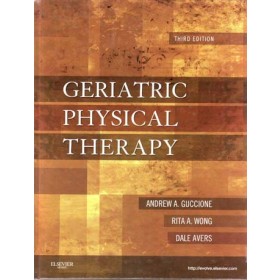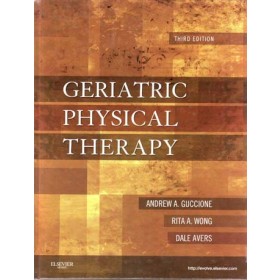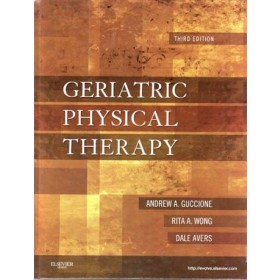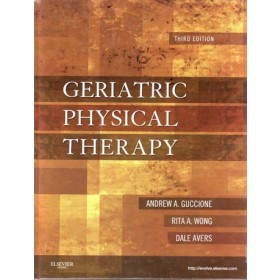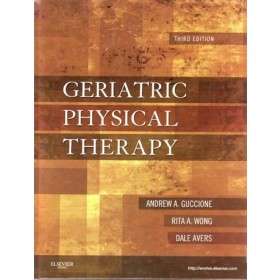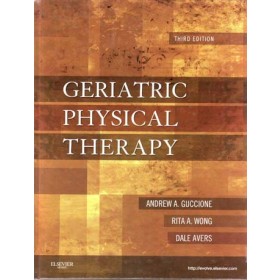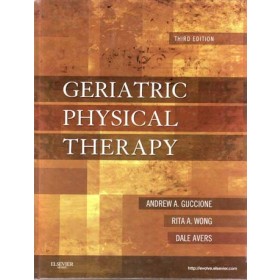Details
Geriatric Physical Therapy: Module 1 (Electronic Download)
SKU: 761E
By Andrew A. Guccione, PT, PhD, DPT, APTA, Rita Wong, EdD, PT and Dale Avers, PT, DPT, PhD.
These courses are offered in cooperation with Elsevier Health and utilize the textbook, “Geriatric Physical Therapy, 3rd Edition” by Andrew A. Guccione, PT, PhD, DPT, APTA, Rita Wong, EdD, PT and Dale Avers, PT, DPT, PhD.
These courses offer a comprehensive presentation of geriatric physical therapy science and practice, with practical information on aging-related changes in function, the impact of these changes on patient examination and evaluation, and intervention approaches that maximize optimal aging. It emphasizes evidence-based content that you can use throughout the patient management process and includes the foundational knowledge you need for clinical success.
Module 1: covers foundations of geriatric care, demography, mortality, and morbidity of older adults, the physiology of age-relate and lifestyle-related decline, geriatric pharmacology and exercise and physical activity for older adults.
Module 2: covers contexts for examination and interventions including patient management principles, sensory and cognition changes in the older adult, evaluation of the acute and medically complex patient, motivation and patient education and the families of older adults.
Module 3: covers evaluation, diagnosis and the plan of care including assessments of aerobic capacity, endurance, joint mobility, muscle performance, motor control, posture, ambulation, functional mobility, balance and falls.
Module 4: covers special problems and interventions including impaired integumentary integrity, urinary incontinence, pain management, lower-limb orthoses and prosthetic management for older adults with lower limb amputations.
Module 5: covers special populations and the continuum of care including wellness for the aging adult, home health, hospice, the senior athlete and older adults with developmental disabilities.
Order this product and it will be available to you immediately after purchase for electronic download in the “My Downloads” section of your account after you have logged in. The download files will require Adobe Acrobat Reader to open. If you do not have Adobe Acrobat installed, you may download it at no charge from Adobe.com.
Course Length: 15.0 contact hours
Instructional level: Intermediate
This package contains the reading and testing materials for Module 1 only.
Geriatric Physical Therapy: Module 1
Course Goals and Objectives:
Course Goals: This course is intended to instruct the student through self-paced study on the foundations of treating a geriatric adult including geriatric physiologic changes, geriatric pharmacology and exercise and physical activity considerations.
Student Objectives:
At the end of this course, the student will be able to:
1. Analyze key principles underlying contemporary geriatric physical therapy
2. Specify 4 functional levels on the Slippery Slope of Aging Scale
3. Differentiate the 4 dimensions of clinical expertise
4. Distinguish the 4 steps typically used to locate and apply best evidence with an unfamiliar clinical situation
5. Distinguish the 4 steps in the “Continuum of Evidence” of scientific studies
6. Specify the best database to use when searching for biomedical evidence
7. Differentiate between components to critically assess the evidence in scientific studies
8. Identify the demographics of the current geriatric population including population, race, life expectancy and sex
9. Specify the 5 most common causes of death for all individuals age 65 or older
10. Identify the average life expectancy of individuals age 65 or older
11. Analyze the most prevalent chronic conditions in individuals age 65 or older and the most prevalent activity limitations from those conditions
12. Identify the difference between ADLs and IADLs
13. Analyze the effects of physical stress on tissue adaptation
14. Differentiate between successful and nonsuccessful aging
15. Distinguish major changes in skeletal tissue, body composition, collagenous tissues, cardiovascular tissues, the nervous system, and immune system associated with aging and the associated clinical consequences
16. Distinguish modifiable and nonmodifiable factors for bone loss
17. Examine the pattern of drug use in older adults
18. Distinguish 7 characteristics of polypharmacy in older adults
19. Examine the pharmacokinetic changes that occur as a result of aging
20. Distinguish factors that increase the risk of adverse drug reactions in older adults
21. Distinguish common adverse drug reactions in older adults
22. Evaluate the effect medications may have on an older adult’s ability to participate in therapy
23. Identify 4 psychotropic drug groups and examples of each
24. Identify the most common form of mental illness in the geriatric population
25. Differentiate between common drugs used in the treatment of neurologic conditions such as Parkinson’s Disease and seizure disorders
26. Differentiate between common drugs used in the treatment of pain and inflammation
27. Identify examples of cardiovascular drugs used to treat hypertension, congestive heart failure, cardiac arrhythmias, angina pectoris, hyperlipidemia and coagulation disorders.
28. Discriminate between examples of respiratory and gastrointestinal drugs
29. Evaluate benefits and risks associated with hormone replacement therapy in older adults
30. Identify common antibacterial and antiviral drugs
31. Identify drugs used in chemotherapy
32. Outline general strategies for coordinating therapy sessions with drug treatment in older adults
33. Outline the CDC Physical Activity Guidelines for Older Adults
34. Evaluate conditions for which physical inactivity is a significant risk factor
35. Distinguish elements of an exercise prescription for an older adult
36. Outline indications, contraindications, benefits and risk factors for aerobic exercise, aquatic exercise, strengthening exercise, stretching exercise, plyometrics and Tai Chi with older adults
